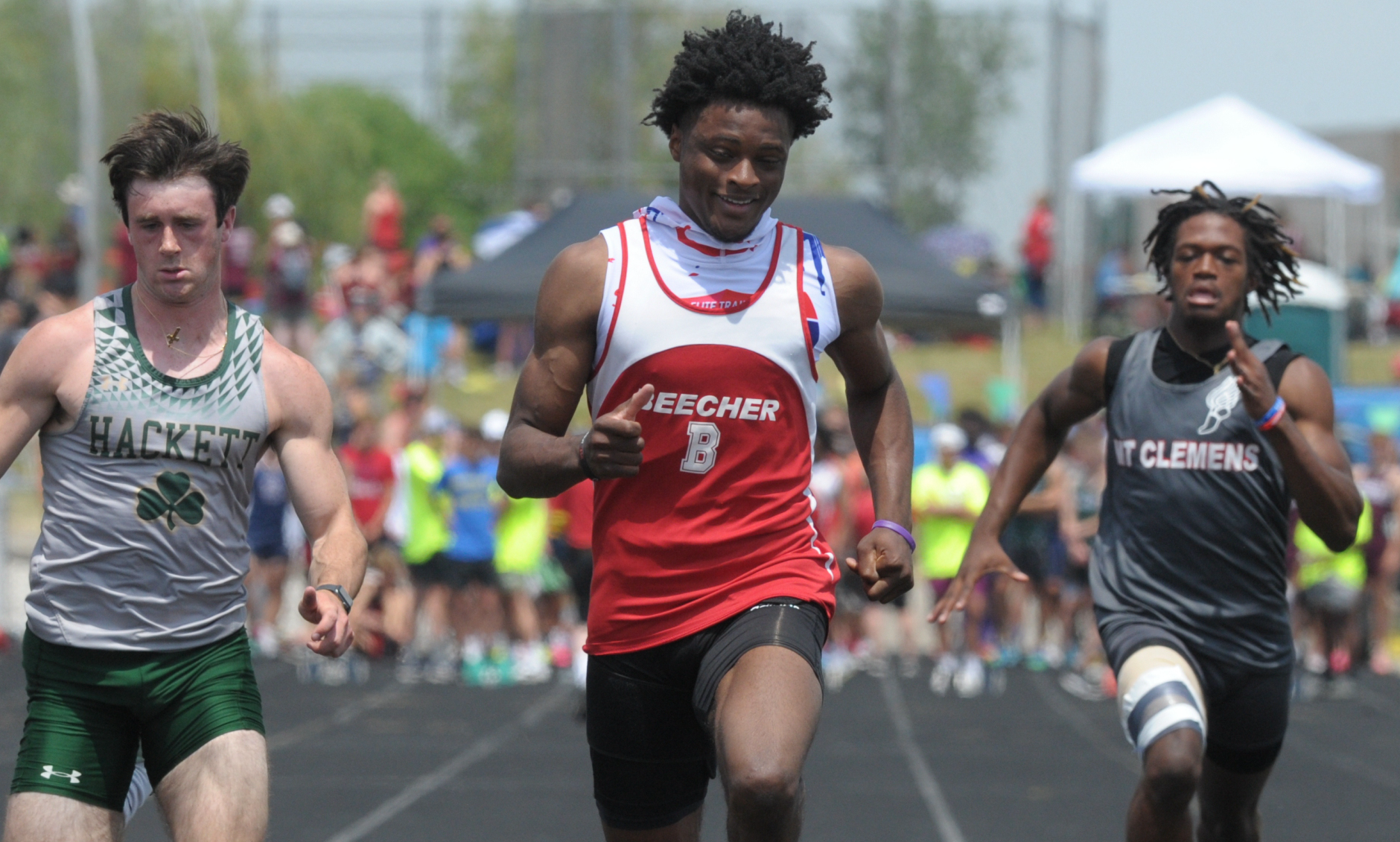
Amid Life's Hurdles, Mendon Sprinter Rises
April 11, 2018
By Wes Morgan
Special for Second Half
Sam Cleveland remembers a day back in elementary school, or at least parts of it, that changed his life forever.
 He recalled feeling lightheaded, seeing a fuzzy image of the floor before passing out. After regaining consciousness, he was taken by ambulance to the hospital.
He recalled feeling lightheaded, seeing a fuzzy image of the floor before passing out. After regaining consciousness, he was taken by ambulance to the hospital.
Now a junior three-sport athlete at Mendon High School, Cleveland was diagnosed with severe hypoglycemia, a condition caused by a low level of blood sugar (glucose), which is the body’s primary energy source. Since then, he has been on a strict diet that requires many meals a day.
Despite the health concern, Cleveland has been able to navigate a twisting path through life, academics and athletics. Without going into detail, his coaches noted how Cleveland had been able to remain focused in the face of a challenging home life as a youngster.
Now he lives with his grandmother, who is battling cancer and relies heavily on the support Cleveland provides. Through all of this, Cleveland has been an integral component to the success of both the Mendon football and wrestling teams. The Hornets advanced to the MHSAA Division 8 Semifinals in football, and the grapplers followed that up this past winter with a trip to the Division 4 Quarterfinals after claiming their first Regional crown in nearly three decades.
Cleveland’s role in football was mostly on special teams, where he returned both a kickoff and a punt for touchdowns in one game. He missed the majority of his sophomore season in 2016 with a broken fibula. On a power-packed wrestling team, Cleveland filled the 152-pound spot when one of the Hornets’ top performers, Kaden Frye, missed a good chunk of the season recovering from a severe leg fracture.
“I’m not very good at it at all,” Cleveland said, noting his still-solid 11-12 record on the mat. “This year I wasn’t going to wrestle. I had a lot of stuff going on personally. It wasn’t appealing at all to me because the year before that I had a really bad year. But I’ve realized wrestling is one of those things that keeps me going. It’s the pinnacle of my athletic ability because of how hard we go. There’s no other practice like wrestling practice.
“I can’t cut weight, or I will die. I have to eat like eight times a day on a schedule. It’s a struggle to wrestle, but I do it anyway because I love my coach and the kids on that team. There’s nothing like that atmosphere. Here at Mendon, wrestling and football are the hardest things you’ll do. We try our best and put everything on the line.”
That Cleveland decided to return for another year of wrestling didn’t surprise coach Caleb Stephenson, who said the student-athlete has accepted a number of challenges he didn’t necessarily ask for in life.
“A kid like Sam is exactly what you think about when you think about small-town sports,” Stephenson said. “He’s so crucial. You’ve got to have these guys that are three-sport athletes. He’s going to give you everything he’s got every single day, and you just love kids like that.
“He’s had to deal with so much more than he ever told you. He’s had a rough upbringing and has had to deal with some things kids shouldn’t have to deal with at such a young age. Without Sam this year, we wouldn’t have been the wrestling team we were. When Kaden got hurt, Sam stepped up. That’s the way he’s grown up. He’s had to; he’s had no choice.”
On the track is where Cleveland’s confidence noticeably comes alive. As a freshman, he qualified for the Division 4 Finals in the 100 meters. Last season, he secured the final (eighth) all-state spot in the event with a time of 11.5 seconds, along with a seventh-place performance with the Mendon 800 relay team and an 11th-place finish with the 400 relay. Cleveland also qualified for the Finals in the long jump.
“He’s a tough kid,” Mendon track coach Vic Wilczynski said. “This might be one of the first years he has started out not hurt. He’s a good leader and is out there working with the younger guys. Not many guys have qualified as a freshman in the 100 (from Mendon), and he followed that up with all-state. You look up at that (program) record board, and there aren’t that many guys up there in the 100, period.”
He may not headline the football and wrestling rosters, but the spring is when Cleveland has a chance to shine.
“I’m pretty psyched about the 100,” Cleveland said as the 2018 track season gets going. “It was never really my thing. In middle school I used to run the 800 and the 400. I never thought of myself as a sprinter, to be honest.
“Track season is the most important season to me. It keeps me in the best shape and is something I thrive at. I strive to be better every day.”
 Wes Morgan has reported for the Kalamazoo Gazette, ESPN and ESPNChicago.com, 247Sports and Blue & Gold Illustrated over the last 12 years and is the publisher of JoeInsider.com. He can be reached at [email protected] with story ideas for Berrien, Cass, St. Joseph and Branch counties.
Wes Morgan has reported for the Kalamazoo Gazette, ESPN and ESPNChicago.com, 247Sports and Blue & Gold Illustrated over the last 12 years and is the publisher of JoeInsider.com. He can be reached at [email protected] with story ideas for Berrien, Cass, St. Joseph and Branch counties.
PHOTO: Mendon’s Sam Cleveland charges forward during a 100-meter preliminary at last season’s Lower Peninsula Division 4 Finals at Houseman Field. Evart’s Major Griffin is to his left, and Wyoming Potter’s House Christian’s Shelton Rodriguez is to his right. (Photo courtesy of JoeInsider.com.)

Thrower Claims Lone Individual Title to Lead Hackett to Team 3-Peat
By
Tom Lang
Special for MHSAA.com
June 3, 2023
Kalamazoo Hackett Catholic Prep just keeps winning and winning.
This time the Irish took home their fourth title in the last five Lower Peninsula Division 4 Track & Field Finals, on Saturday at Hudsonville.
Hackett’s only individual title was taken by discus winner Nathan Buchmann, a senior, who was fine knowing he was the shortest in stature among all the sizable competitors.
“In the offseason after football I worked out every day, working towards this goal,” he said after getting his medal. “I would say this takes 80 percent technique and 20 percent strength to throw the discus. So, length can help but if you have good technique and are really strong, that will play into it.
“I think we are very balanced throughout the meet today,” he said about teammates that scored points in finishes other than first place. “We have 13 guys here today, and we have people in a lot of the races. But I do not run; I have too short of legs to be a fast runner,” he said with a chuckle.
Buchmann had to work through a hip injury to compete this spring.
“I think the setbacks are what make you strong,” he said. “You can either give up through the setbacks or push forward and become better.”
 Coach Charissa Dean agreed.
Coach Charissa Dean agreed.
“The kids have big hearts,” she said after all the points were totaled and the Irish were on top once again, with 53. “They worked hard. They had a lot of potential when we started the season. And we had a lot of drive to put in the work, and we are happy the results came out the way they did.”
Reading was runner-up at 47 points, followed by Wyoming Potter’s House Christian with 42, then Fowler and Flint Beecher each with 37 points.
Senior Lezawe “Moses” Osterink, of Potter’s House Christian, placed second in 1,600 but took the 3,200 title as defending champ of both. He dominated the latter by lapping the field with a final lap kick that resembled more of a superhero speedster.
“Nobody really took it out that hard at the start,” he said. “There was a freshman (Marek Butkiewicz of Hackett) that tried to get the pace going quick, but me and Dakota (Dykhuis of Montabella) just kind of sat back and gradually pulled him through.
“We took it gradually, and I was just relying that I could kick.”
Kick did he ever. The trio were neck and neck the majority of the race in a grouping ahead of the pack.
“With 400 to go I just tried to go all out,” Osterink said. “I had a lot more left than I thought and I was pleased with the win. Not really the time, but that doesn’t matter, especially this hot out.”
The overall meet was in the low 90s/high 80s heat and searing sun all day. So, race officials allowed the unique opportunity for coaches to spray the runners with water and give them water bottles.
“It was very weird because I’ve never taken water to drink while I’m running, so I didn’t know how that would feel,” Osterink said. “And they were spraying us and hitting us in the face. It was kind of fun.”
Junior Tyler Lenn of Marine City Cardinal Mooney defeated Osterink at his own game in the 1,600.
“I’m feeling great,” Lenn said after grabbing the medal. “I said to a newspaper after one of my races (during the season) I was right where I wanted to be. This has been a long rebuilding process for me since an injury back in the fall, and I set a pretty high goal the day the injury happened. I was telling myself I needed to fulfill what I said I would do at the beginning of last cross country season. And that is what I did today.”
Lenn suffered an ankle sprain from a misstep that turned worse because he kept running through the season on it.
“Coming back from that was pretty tough, but I wouldn’t have it any other way,” he said.  “Perseverance; I said from the beginning what I was going to do. I kept my eye on that target, and no matter the circumstances life threw at me, that I was going to make it happen and I am a man of my word.”
“Perseverance; I said from the beginning what I was going to do. I kept my eye on that target, and no matter the circumstances life threw at me, that I was going to make it happen and I am a man of my word.”
Jaylin Townsend, a senior from Flint Beecher, dominated the short races. He won the 100 dash (10.67) and 200 dash at 22 seconds flat. It was his third 100 win at a Finals.
“I put in a lot of work; I had to three-peat,” he said after the 100. “There’s a lot of great competition here, so I knew I had to come out and run my best.”
Concord in the 400 (43.72), Buckley in the 800 (1:30.76) and 1,600 (3:29.13) and Potter’s House in the 3,200 (8:14.18) were relay champs Saturday. Reading’s Tayshawn Bester won the 110 hurdles (15.13), and Athens’ Landen Bennett won the 300 (39.85). Caseville’s Nathan Feltner won the 400 (50.76), and Vestaburg’s Owen Patton claimed the 800 (1:55.11).
Fruitport Calvary Christian’s Bradley Richards won the high jump (6-10), and Peck’s Alex Affer won the long jump (23-4). McBain Northern Michigan Christian’s Isaac Bowden was first in pole vault (13-0), and Brown City’s Kyle Affer won shot put (49-2).
PHOTOS (Top) Kalamazoo Hackett Catholic Prep celebrates its third-straight LPD4 title Saturday. (Middle) Cardinal Mooney's Tyler Lenn, far right, sets the pace in the 1,600. (Below) Flint Beecher's Jaylin Townsend, middle, crosses the finish first for one of his two sprint championships. (Photos by Ken Swart/RunMichigan.com.)

